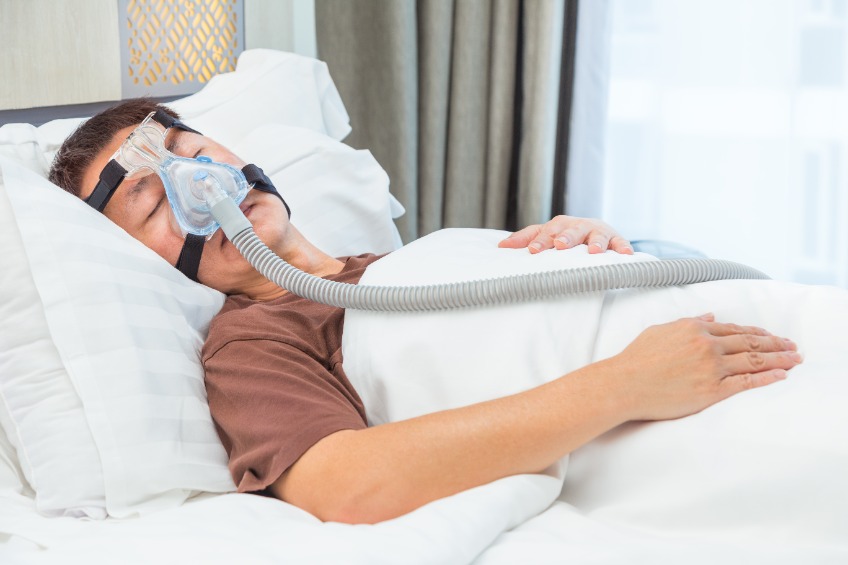Understanding insurance coverage can be as complicated as to understanding and/or explaining rocket science, maybe more so because there are no constants with everchanging legislative updates, employer-related changes, as well as insurance company changes regarding your plan’s coverages, copays*, preauthorization*, deductibles*, coinsurance*, FSA and HSA thresholds, provider’s network and prescription coverage, and so on and on.
We are going to attempt to break down some of the basics on how your insurance works when it comes to your CPAP equipment and supplies coverage. And we’ll discuss how your Durable Medical Equipment (DME) supplier* can assist and manage the processing of your insurance payments, as well as how the staff at Everything CPAP works closely with our patients to make the process as seamless and efficient as possible. We’ll do this in Question-and-Answer format, including the top questions we are asked by our patients.
How much does CPAP Therapy cost?

From diagnosis to ongoing treatment, the price of CPAP therapy can vary greatly depending on what your physician prescribes and what your insurance covers. The cost from diagnosis to resupplies are listed below (prior to insurance coverage):
- The overnight Sleep Study exams can range $600 to $5,000 or more each night. Depending on where and how the study is performed; Attended hospital setting, Independent Diagnostic Testing Facility (IDTF), Home Sleep Study, etc.
- Positive Airway Pressure (PAP) devices can cost about $1,000-$3,000 or more depending on the make and model of the machine and its features.
- Air filters can cost $5 to $10 each.
- Hose and tubing can cost $20 or less, but those that offer more features, like heated tubes, can be up to $60.
- Headgear and masks typically cost about $100 or more.
- CPAP Supplies (filters, cushions, mask frames) can range from $60-80 per month, once you own your CPAP machine.
When do I know it’s time to replace my CPAP supplies?
Just because you may be eligible for replacement supplies, you are certainly not required to purchase any supplies. Good indications that it’s time to replace your supplies are when the mask cushion deteriorates and becomes too soft to seal effectively or when the headgear straps lose elasticity and must be tightened more and more to get the same quality seal. We strongly suggest replacing mask cushions and filters monthly or as soon as they start to soften. Air leaks may reduce the effectiveness of CPAP therapy and headgear that is too tight may cause facial sores at pressure points. (See glossary for a standard insurance resupply schedule).
What is the Patients’ Responsibility when it comes to their DME Supplies and Insurance?

NOTIFY DME OF ANY/ALL INSURANCE CHANGES: Please notify your DME Supplier of any changes in insurance coverage for you and your dependents. If we process your claim to an insurance company that no longer covers you, we have to wait for denial, research the reason, issue a new claim to the correct insurance which all can prolong payment, and can hinder preauthorization of your CPAP therapy.
If your new insurance requires a prior authorization, your claim could be denied if sent initially to your former insurance company. The prior authorization must be fulfilled prior to the purchase, so if your bill of sale shows a date earlier than the prior authorization approval, the claim will be denied. We cannot alter the date on your bill of sale. So, to avoid this logistical nightmare and administrative headache, ensure your DME has the correct insurance information before any purchase or claim is made.
Each DME billing department is graded on their Denial Rates, even if the denial is not the fault of the DME, it’s still results in a penalty on the Denial Rate. An acceptable denial rate is no higher than 10% but the billing department at Everything CPAP is less than 1%. Why? Our billing staff adheres to strict policies that result in very clean billing, accuracy of information submitted, and the ability to renegotiate rates with insurance to ensure fair and accurate billing. When we submit a claim, it’s a Clean Claim, meaning that the insurance has all the information they need, including the reasons of medical necessity in the sleep study, the patient’s physician’s notes, with all the correct Diagnosis Codes, CPT and HCPCS codes. This avoids denials, the need for appeals, and the back and forth of paperwork which cause the insurance company and the DME preventable administrative work and cost, as well as frustration to the patient as they wait for coverage.
NOTIFY DME OF ALL CONTACT INFORMATION AND OTHER CHANGES: Please notify your DME supplier of any change in address, phone, email, contact information, marital status, dependents’ changes, change of sleep physician or primary care physician, and any other information that could delay or impair a speedy claim approval, for all the reasons already discussed.
UNDERSTAND YOUR INSURANCE PLAN: There are at least five to six types of insurance plans with an innumerable list of options, restrictions, exceptions and exclusions. So, before you decide, make sure you talk to your employer and your human resources department to fully understand the insurance plans that you are being offered and how those plans determine your coverage. Ask them: what is the percentage of your financial responsibility? Where and who is include in the network of care? Can I see medical professionals outside the network? What the current rate of deductible, copays, prescription and DME coverage? The types of health insurance plans you should know about are: (all are defined in the glossary)
- Preferred provider organization (PPO) plan
- Health maintenance organization (HMO) plan
- Point of service (POS) plan
- Exclusive provider organization (EPO)
- Health savings account (HSA)-qualified plan
- Indemnity plans
UNDERSTAND YOUR INSURANCE COVERAGE FOR DME: It is the patient’s responsibility to know the amount of coverage and limitations for your CPAP machine, mask, and supplies. CPAP will fall under the category of “DME SUPPLIES” in your insurance plan explanation of benefits. There is often a lack of understanding when it comes to a patient’s specific DME coverage including CPAP therapy. For example, the percentage of DME coverage is not the same when compared to the coverage of a physician’s office visit.
DME Benefits can range from no coverage to 70-80% (most common) to 100% coverage. If you need help understanding your insurance coverage and prior authorization regulations, the staff at Everything CPAP has the expertise and experience to guide you through the somewhat complicated language. It is advantageous and cost-effective for most insurance companies to cover CPAP equipment and therapy, as it prevents comorbidities that are far more expensive to treat.
“Frost & Sullivan calculated that the annual economic burden of undiagnosed sleep apnea among U.S. adults is approximately $149.6 billion. The estimated costs include $86.9 billion in lost productivity, $26.2 billion in motor vehicle accidents and $6.5 billion in workplace accidents. Untreated sleep apnea also increases the risk of costly health complications such as hypertension, heart disease, diabetes and depression. The report estimates that undiagnosed sleep apnea also costs $30 billion annually in increased health care utilization and medication costs related to these comorbid health risks.” – AASM,org (2016)
Why is the end of the year one of the best times of the year to reorder your CPAP supplies and replacements?

Patients who have deductibles on their insurance plans have more than likely met their specific deductible by the end of the year. So, the months of November and December are one of the most popular times of the year for patients to reorder ancillary supplies (such as tubes, filters, water chambers, cushions, mask frames, headgear, and whole mask if needed).
Even if these items are not fully worn out, it might be a good idea to be proactive and order those supplies now. It may be the most cost-effective time to order in the last quarter of the year but only if the items ordered are subject to your insurance’s resupply schedule. The schedule we show in the glossary below is the most standard resupply schedule, which was originally determine by Medicare, often considered the gold standard for which all the other insurance companies consider before making their own decisions. Always check your insurance’s DME coverages before ordering, for any limitations or exemptions.
Also, please note if paying by cash (where insurance coverage is not an issue), ordering supplies anytime of the year is suitable. If paying by cash, order whenever you want or need your supplies. Unfortunately, ordering outside of the resupply schedule may also be necessary if your CPAP device is stolen, lost or damaged during circumstances beyond your control. You would not believe how many times our patients have needed a new mask or supplies because their dog chewed or damaged it. In those cases, ordering outside of the resupply schedule may be necessary.
Do you still have questions about CPAP (DME) Coverage of your particular insurance plan?
Our staff at Everything CPAP of Boise, ID is very thorough, experienced, and knowledgeable on the various types of insurance plans and what they cover. Before any claim is issued, our staff works closely with the patient to ensure correct insurance information, after which they will verify insurance coverage and percentage of coverage directly with the carrier prior to the patient’s CPAP therapy medical devices are ordered. This is not a requirement, but we hope to remove the hassle and frustration that can come from insurance denials, request for more information or anything delaying the process of getting your needed equipment and supplies covered. If you don’t know what questions to ask to determine coverage, we are here to communicate directly with the insurance carriers on our patients’ behalf. Call us today to setup an appointment.
GET STARTED ON A BETTER NIGHT’S SLEEP:
*Whenever you see an asterisk, please refer to the glossary (below).
GLOSSARY:

- Durable medical equipment is any medical equipment used in the home to aid in a better quality of living. It is a benefit included in many insurance policies and in some cases covered by Medicare benefits.
- A DME supplier is any business that sells, or rents certain types of medical equipment intended for the management of chronic conditions.
- Insurance Deductible: The amount you pay for covered health care services before your insurance plan starts to pay. With a $2,000 deductible, for example, you pay the first $2,000 of covered services yourself. After you pay your deductible, you usually pay only a coinsurance.
- Copay or Copayments are fixed amounts ($20, for example) you pay for a covered health care service after you’ve paid your deductible.
- Coinsurance is the percentage of costs of a covered health care service you pay (20%, for example) after you’ve paid your deductible.
- Your Max out of Pocket is the most you have to pay for covered services in a plan year. After you spend this amount on deductibles, copayments, and coinsurance for in-network care and services, your health plan pays 100% of the costs of covered benefits.
- Preferred provider organization (PPO) plan is a type of health plan that contracts with medical providers, such as hospitals and doctors, to create a network of participating providers. You pay less if you use providers that belong to the plan’s network.
- Health maintenance organization (HMO) plan is a type of health insurance plan that usually limits coverage to care from doctors who work for or contract with the HMO. It generally won’t cover out-of-network care except in an emergency.
- Point of service (POS) plan is a type of plan in which you pay less if you use doctors, hospitals, and other health care providers that belong to the plan’s network. POS plans also require you to get a referral from your primary care doctor in order to see a specialist.
- Exclusive provider organization (EPO) is a managed care plan where services are covered only if you go to doctors, specialists, or hospitals in the plan’s network (except in an emergency). An EPO is more restrictive than a PPO, with less coverage or reimbursement for out-of-network providers but is also often cheaper.
- Indemnity plans are also referred to as “fee-for-service” plans. Indemnity insurance allows you the freedom to choose your own medical provider or healthcare services without worrying about if it’s in the insurance provider’s network or not. As a supplement to a major medical or health insurance plan, indemnity health insurance can also help cover the costs of specific healthcare circumstances. With indemnity insurance, a specific percentage of your healthcare costs are covered, and you’ll be expected to pay the rest.
- A Health Savings Account (HSA) is a type of personal savings account you can set up to pay certain health care costs. An HSA allows you to put money away and withdraw it tax free, as long as you use it for qualified medical expenses, like deductibles, copayments, coinsurance, and more. The government sets the threshold amount you can set aside tax free, and the savings account does not expire. Theses plans have high deductibles.
- A Flexible Spending Account (FSA) is an arrangement through your employer that lets you pay for many out-of-pocket medical expenses with tax-free dollars. Allowed expenses include insurance copayments and deductibles, qualified prescription drugs, insulin, and medical devices. This is a use-it-or-lose-it type plan which usually expires over one calendar year, but some employers offer a 90 day grace period. The maximum threshold amount you can have in an FSA Account in 2022 is $3050, according to Healthcare.gov.
- CPAP Resupply Schedule with most insurance plans: (check your insurance under “DME resupply” schedule for changes or exceptions to the following)
- Every month: (1) full face mask cushion; (2) nasal mask cushions; (3) disposable filters;
- Every 3 months: (1) full face or nasal mask (this does not include the headgear; (2) heated tube;
- Every 6 months: (1) headgear; (2) non-disposable filter
- Please Note: You may be eligible to receive coverage for certain supplies during specific periods of time. The supplies are generally subject to your deductible and coinsurance. Being eligible for supplies does not mean that your insurance will cover the cost of any or all of the supplies.
- Insurance Preauthorization: Prior authorization—sometimes called preauthorization, precertification or prior approval—is a health plan cost-control process by which physicians and other health care providers must obtain advance approval from a health plan before a specific service is delivered to the patient to qualify for payment coverage. Prior authorization can be received the same day or up to 24 hours, while federal plans can take up to a week.
- Diagnosis codes describe an individual’s medical condition and are required on claims submitted by health care professionals to third party payers.
- Current Procedural Terminology (CPT®) codes offer doctors and health care professionals a uniform language for coding medical services and procedures to streamline reporting, increase accuracy and efficiency.
- HCPCS codes are a collection of standardized codes that represent medical procedures, supplies, products and services. The codes are used to facilitate the processing of health insurance claims by Medicare and other insurers.








